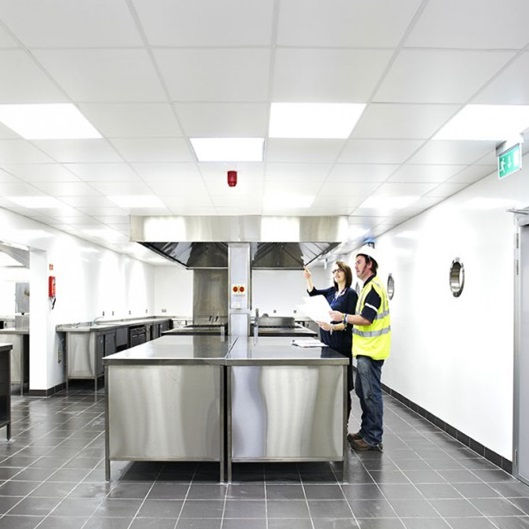Where Can Hygienic Wall Cladding Be Used? Practical Applications for Homes and Businesses.
- tim7892
- 1 day ago
- 4 min read
What is hygienic wall cladding, and why is everyone using it?
If you’ve ever struggled with scrubbing grout lines in your bathroom, or spent hours trying to keep a kitchen wall free from grease and stains, you’ll know how much of a headache traditional finishes like tiles or paint can be. This is where hygienic wall cladding comes in.
Made from smooth, durable PVC panels, hygienic wall cladding is designed to be waterproof, easy to clean, and resistant to mould and bacteria. Unlike tiles, there are no grout lines to trap dirt, and unlike paint, it won’t peel or flake over time. A quick wipe down is usually all it takes to keep walls looking spotless.
Because it’s such a practical, low-maintenance option, it’s now being used everywhere — in homes, commercial kitchens, healthcare facilities, gyms, hotels, factories, and more. You can see the full range of options over at Hygienic Sheets, one of the UK’s go-to suppliers for PVC wall cladding.
Bathrooms and kitchens at home
One of the most popular uses for hygienic wall cladding is in the home. Bathrooms and kitchens are constantly exposed to moisture, steam, and spills, and cladding offers a simple solution to keep walls protected.
In bathrooms, cladding panels are completely waterproof, so they’re ideal for shower enclosures, around baths, and even as full wall coverings. They also cut down on cleaning time — no more scrubbing mouldy grout lines, just a quick wipe with a cloth. Many homeowners find that cladding makes their bathroom feel brighter and more modern too.
In kitchens, wall cladding can handle everything from steam to cooking splashes, and it’s much easier to clean than paint or tiles. It’s a practical choice for busy households where time is short, and it works brilliantly as an alternative to traditional splashbacks.
Food prep and catering spaces
Commercial kitchens and food preparation areas are under constant pressure to meet strict hygiene regulations. Walls need to be smooth, wipeable, and resistant to bacteria. Hygienic PVC wall cladding ticks all of those boxes.
That’s why you’ll find it in restaurants, cafés, takeaways, bakeries, and large-scale catering facilities. The panels create a seamless surface that doesn’t let dirt or germs build up, making daily cleaning quick and efficient. And because they’re much faster to install than tiles, kitchen refurbishments can be completed in less time, which means less disruption to business.

Hospitals, clinics, and care homes
Healthcare environments are another place where hygienic wall cladding really comes into its own. Hospitals, GP surgeries, dental practices, and care homes need wall finishes that are durable, safe, and easy to sanitise. Painted walls can chip, and tiles often have grout lines where bacteria can hide, but PVC panels create a smooth surface that’s easy to keep clean.
White panels are often used in clinical spaces, while soft pastel shades are popular in wards and waiting rooms to create a more calming atmosphere for patients. The combination of hygiene and comfort makes cladding a trusted choice across the healthcare sector.

Gyms, spas, and hotels
Leisure and hospitality venues see heavy use and high moisture levels, so keeping walls fresh can be a challenge. Hygienic wall cladding is a practical way to make sure spaces like gym showers, spa treatment rooms, hotel bathrooms, and swimming pool changing areas stay hygienic and easy to maintain.
Unlike tiles, the panels won’t crack or discolour, and they keep their good looks even after years of constant use. For businesses in the hospitality industry, they’re also a great way to provide a professional, modern appearance without creating extra work for staff.

Industrial and commercial spaces
Factories, warehouses, and production facilities also make use of hygienic wall cladding. In these environments, durability is just as important as cleanliness. Cladding panels can withstand daily knocks and wear while still providing a surface that’s easy to wash down.
In industries like food manufacturing, pharmaceuticals, and cold storage, hygienic wall cladding is often essential for meeting health and safety standards. Even in less demanding industries, it’s a cost-effective way to protect walls and cut down on maintenance.
Why hygienic wall cladding works everywhere
So, why has hygienic wall cladding become so widespread? It’s because it offers a mix of benefits that few other wall coverings can match:
It’s fully waterproof and mould-resistant.
The smooth surface makes cleaning quick and easy.
Installation is faster and more affordable than tiling.
Panels are long-lasting and hard-wearing.
A wide choice of colours and finishes means you don’t have to sacrifice style for practicality.
This flexibility is why hygienic cladding works just as well in a family bathroom as it does in a hospital or factory. It’s one of those rare products that genuinely fits into almost any setting.
Final thoughts
Hygienic wall cladding started out as a practical solution for hospitals and commercial kitchens, but today it’s being used just about everywhere. From bathrooms and kitchens at home to gyms, restaurants, hotels, factories, and care homes, it’s a low-maintenance option that delivers on hygiene, durability, and style.
If you’re planning a project and want a wall covering that’s simple to install, easy to clean, and built to last, hygienic PVC wall cladding is a smart choice. You can explore a wide range of colours, trims, and finishes at Hygienic Sheets, making it easy to find the right option for your space.





Comentarios